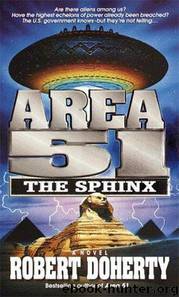Area 51: The Sphinx by Robert Doherty

Author:Robert Doherty
Language: eng
Format: mobi, epub
Tags: Science Fiction
ISBN: 9780440234944
Publisher: Dell
Published: 2000-02-07T11:00:00+00:00
CHAPTER 15
Area 51
D - 27 Hours, 30 Minutes
Larry Kincaid had worked around scientists all his life and was a scientist himself, but he had little patience for the intellectual type whose specialty was so narrow they couldn’t program their VCR. The scientist in front of him was one of those, and Kincaid had to force himself to try to figure out what the man was trying to say as he babbled at the mouth.
Joe Forrester was a NASA specialist and the head of the Hubble Telescope division. Forrester fit the NASA geek stereotype to a T, even to the extent of the pocket protector holding his pens and the sophisticated calculator behind the protector. His wire-rimmed glasses held thick lenses, and Kincaid found himself disoriented every time he tried to look the man in the eyes.
Kincaid was one of the few left at JPL and NASA from the early, exciting days of the space program. He wasn’t a specialist, but a jack-of-all-trades. He had been mission head for all Mars launches, a job that had thrust him into the spotlight when the Airlia base on Mars had been uncovered in the Cydonia region. He’d brought Forrester to Area 51 to coordinate surveillance on the Airlia base on Mars.
“Hubble is capable of tracking moving targets with the same precision as for fixed targets.” Forrester spoke as he typed into his laptop, which was hooked into the secure Department of Defense Interlink. “The images you had of Mars before were just snapshots taken by the Hubble’s FOC—faint object camera.”
Kincaid had dealt with men like this for decades, so he knew enough to just let Forrester talk as he worked.
“To track a moving object in our solar system we maintain a FGS—fine guidance sensor—fine lock on guide stars, and drive the FGS star sensors in the appropriate path, thus moving Hubble to track the target. Tracking under FGS control is technically possible for apparent target motions up to five arcsec.” Forrester looked up. “That is how we were initially able to follow the talon fleet as it came toward Earth.
“However, as happened in that case, this technique becomes unfeasible for targets moving more than a few tenths of an arcsec. What we do then is begin observations under FGS control and then switch over to gyros when the guide stars have moved out of the FGS field of view. If sufficient guide stars are available, it is possible to hand off from one pair to another, but this will typically incur an additional pointing error.”
With great difficulty, Kincaid still said nothing.
“Targets moving too fast for FGS control, but slower than seven point eight arcsec, can be observed under gyro control, with a loss in precision that depends on the length of the observation.”
“Can you see Mars?” Kincaid finally asked.
“We’ve always been able to see Mars,” Forrester said. “What you want is to see it with the full capabilities of Hubble, and I’m trying to explain to you what is needed to accomplish that.” Forrester continued without missing a beat.
Download
This site does not store any files on its server. We only index and link to content provided by other sites. Please contact the content providers to delete copyright contents if any and email us, we'll remove relevant links or contents immediately.
| Assassinations | Conspiracies |
| Espionage | Political |
| Terrorism |
The Wolf Sea (The Oathsworn Series, Book 2) by Low Robert(35138)
Crowbone (The Oathsworn Series, Book 5) by Low Robert(33525)
The Daughters of Foxcote Manor by Eve Chase(23523)
The Silent Patient by Alex Michaelides(19473)
Shot Through The Heart (Supernature Book 1) by Edwin James(18853)
The Secret History by Donna Tartt(18846)
All the Missing Girls by Megan Miranda(15572)
Ready Player One by Cline Ernest(14524)
The Betrayed by Graham Heather(12746)
The Betrayed by David Hosp(12659)
Red by Erica Spindler(12476)
Bull's Eye Sniper Chronicles Collection (The Second Cycle of the Betrayed Series) by McCray Carolyn(12296)
Kathy Andrews Collection by Kathy Andrews(11730)
Warriors (9781101621189) by Young Tom(10742)
Invisible Girl by Lisa Jewell(10416)
The Last by Hanna Jameson(10147)
Year One by Nora Roberts(9700)
Mindhunter: Inside the FBI's Elite Serial Crime Unit by John E. Douglas & Mark Olshaker(9201)
Tell Tale: Stories by Jeffrey Archer(8976)
